Not all ghosts seem to
realize they are dead. Several friends and acquaintances have told me stories that indicate that the
spirit they encountered didn’t know they were dead.
In Corrales, a small village located in the north valley near Albuquerque this type of encounter has happened more than once.
In Corrales, a small village located in the north valley near Albuquerque this type of encounter has happened more than once.
One confused ghost that
appears in Corrales is a Civil War soldier.
A resident of this village told me that as he walked along the back fence of his property--he spotted a young man dressed in an old fashioned Civil War uniform come out of his neighbor's old shed. This soldier then approached him.
A resident of this village told me that as he walked along the back fence of his property--he spotted a young man dressed in an old fashioned Civil War uniform come out of his neighbor's old shed. This soldier then approached him.
This young man who appeared
to be dazed asked the man, “Where am I?” The property owner then discovered
this young man didn’t seem to know the date or even the year.
Before he could offer his assistance, this soldier just walked off and then disappeared.
Before he could offer his assistance, this soldier just walked off and then disappeared.
Months later, one of
his neighbors told him that he most likely encountered this same soldier-- who
didn’t seem to know he was out of place and time. He then discovered his daughter had talked to this ghost as well.
All three of these encounters happened in broad daylight.
All three of these encounters happened in broad daylight.
Seeing a Civil War soldier
was startling but not surprising to these two men because there were battles
fought in Albuquerque and the surrounding areas during this war.
This type of ghost encounter
is frustrating. One has to wonder why this poor soul seemed to
be stuck in a state of limbo.
A similar story, to these two encounters, happened to two sisters when they went to visit their mother’s grave.
A similar story, to these two encounters, happened to two sisters when they went to visit their mother’s grave.
As they were leaving, they
noticed a man walking between the gravestones. When they reached the road where
their car was parked, the man caught up to them.
The cemeteries’ groundskeeper drove past and waved to the two women. He didn’t seem to notice the man.
The cemeteries’ groundskeeper drove past and waved to the two women. He didn’t seem to notice the man.
The man then turned to them
and asked for help. He explained to them, “people all day had been acting like
they didn’t even see him.” He stated that he had woken up in the graveyard that
morning and that his friend must have left him there.
The man became more and more
agitated as he talked to the two sisters. Now nervous, they moved quickly toward
their car.
They both looked back briefly and were stunned to see the man was nowhere in sight. Now scared, they wondered how he could just disappear so quickly in such a vast open space.
They both looked back briefly and were stunned to see the man was nowhere in sight. Now scared, they wondered how he could just disappear so quickly in such a vast open space.
As they drove off, they both
realized they had just seen a ghost. To this day, they still wonder about his
confusion.






















